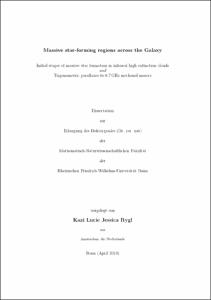Rygl, Kazi Lucie Jessica: Massive star-forming regions across the Galaxy : Initial stages of massive star formation in infrared high extinction clouds and Trigonometric parallaxes to 6.7GHz methanol masers. - Bonn, 2010. - Dissertation, Rheinische Friedrich-Wilhelms-Universität Bonn.
Online-Ausgabe in bonndoc: https://nbn-resolving.org/urn:nbn:de:hbz:5N-22034
Online-Ausgabe in bonndoc: https://nbn-resolving.org/urn:nbn:de:hbz:5N-22034
@phdthesis{handle:20.500.11811/4610,
urn: https://nbn-resolving.org/urn:nbn:de:hbz:5N-22034,
author = {{Kazi Lucie Jessica Rygl}},
title = {Massive star-forming regions across the Galaxy : Initial stages of massive star formation in infrared high extinction clouds and Trigonometric parallaxes to 6.7GHz methanol masers},
school = {Rheinische Friedrich-Wilhelms-Universität Bonn},
year = 2010,
month = jul,
note = {Star-forming regions trace the spiral structure of the Galaxy. They are regions of increased column density and therefore traced well by the extinction in the mid-infrared based on the Spitzer/GLIMPSE 3.6-4.5 micron color excess maps. A sample of 25 high extinction clouds (HECs) was studied in the 1.2 mm dust continuum emission, and followed up by observations of ammonia plus several other molecules using the Effelsberg 100m, IRAM 30m and APEX telescopes. With these data we want to investigate the most early stages of massive star formation, which are currently still largely unknown. Three cloud classes were defined from their morphology in the 1.2\,mm continuum maps: the early diffuse HECs, with a low contrast between the clump and cloud emission; the peaked HECs, with an increased contrast; the late multiply peaked HECs, with more than one clump and a high contrast between the clump and the cloud emission. The clouds are cold (T ~ 16 K) and massive (M ~ 800 M_sun) and contain dense clumps (n ~ 10^5 cm^{-3}) of 0.3 pc in size. These clumps were investigated for evidence of gravitational collapse or expansion, for high velocity outflows, and for the presence of young stellar objects. Based on these results we interpret the three cloud classes as an evolutionary sequence of star-forming clouds. Accurate distances are a crucial parameter for establishing the mass, size, and luminosity of an object. Also, for understanding the spiral structure of the Galaxy trustworthy distances are necessary. The most accurate method to measure these is the trigonometric parallax. Using the European Very Large Baseline Interferometry Network of radio antennas we measured, for the first time, parallaxes of 6.7 GHz methanol masers. This transition belongs to the strongest maser species in the Galaxy, it is stable and observed toward numerous massive star-forming regions. We measured distances and proper motions toward L 1287, L 1206, NGC 281-W, ON 1 and S 255, and obtained their 3-dimensional space velocities. Similar to previous studies, these star-forming regions rotate slower than Galactic rotation.},
url = {https://hdl.handle.net/20.500.11811/4610}
}
urn: https://nbn-resolving.org/urn:nbn:de:hbz:5N-22034,
author = {{Kazi Lucie Jessica Rygl}},
title = {Massive star-forming regions across the Galaxy : Initial stages of massive star formation in infrared high extinction clouds and Trigonometric parallaxes to 6.7GHz methanol masers},
school = {Rheinische Friedrich-Wilhelms-Universität Bonn},
year = 2010,
month = jul,
note = {Star-forming regions trace the spiral structure of the Galaxy. They are regions of increased column density and therefore traced well by the extinction in the mid-infrared based on the Spitzer/GLIMPSE 3.6-4.5 micron color excess maps. A sample of 25 high extinction clouds (HECs) was studied in the 1.2 mm dust continuum emission, and followed up by observations of ammonia plus several other molecules using the Effelsberg 100m, IRAM 30m and APEX telescopes. With these data we want to investigate the most early stages of massive star formation, which are currently still largely unknown. Three cloud classes were defined from their morphology in the 1.2\,mm continuum maps: the early diffuse HECs, with a low contrast between the clump and cloud emission; the peaked HECs, with an increased contrast; the late multiply peaked HECs, with more than one clump and a high contrast between the clump and the cloud emission. The clouds are cold (T ~ 16 K) and massive (M ~ 800 M_sun) and contain dense clumps (n ~ 10^5 cm^{-3}) of 0.3 pc in size. These clumps were investigated for evidence of gravitational collapse or expansion, for high velocity outflows, and for the presence of young stellar objects. Based on these results we interpret the three cloud classes as an evolutionary sequence of star-forming clouds. Accurate distances are a crucial parameter for establishing the mass, size, and luminosity of an object. Also, for understanding the spiral structure of the Galaxy trustworthy distances are necessary. The most accurate method to measure these is the trigonometric parallax. Using the European Very Large Baseline Interferometry Network of radio antennas we measured, for the first time, parallaxes of 6.7 GHz methanol masers. This transition belongs to the strongest maser species in the Galaxy, it is stable and observed toward numerous massive star-forming regions. We measured distances and proper motions toward L 1287, L 1206, NGC 281-W, ON 1 and S 255, and obtained their 3-dimensional space velocities. Similar to previous studies, these star-forming regions rotate slower than Galactic rotation.},
url = {https://hdl.handle.net/20.500.11811/4610}
}






